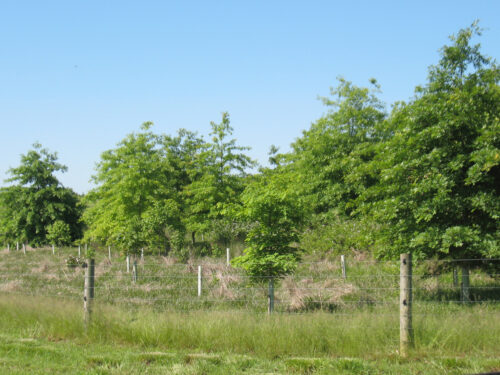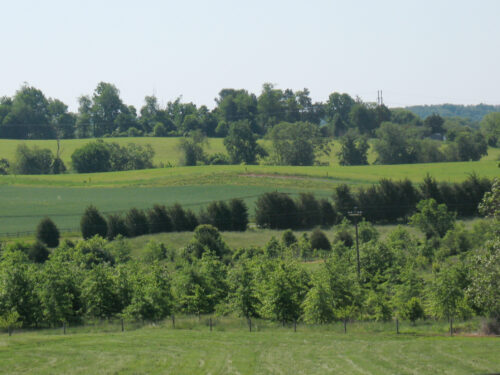
Natural and human-caused activities affect water quality and availability, including extreme weather events, wildfires and changes in land use. Clearing forests and developing land for residential, commercial or industrial uses can negatively influence water quality by increasing the speed of runoff and reducing the ability of the land to filter pollutants such as sediment and excess nutrients from runoff. One effective tool for helping to slow the speed of and filter pollutants out of the water is to establish healthy riparian forest buffer zones along streams and other waterbodies.
Riparian Forest Buffer: a linear wooded area of varying width near a water feature that helps to filter nutrients, sediments and other pollutants from runoff, as well as removes nutrients from groundwater. Riparian refers to water features, so riparian forest buffers are transition areas that protect streams, creeks or other water bodies from pollutants.
As runoff enters a riparian forest buffer, the forest floor slows down the water, allowing sediment to settle out of the water before entering the body of water. This also reduces the amount of sediment and excess nutrients that the runoff picks up from agricultural lands and impervious surfaces, keeping our waterways clean and healthy. Slowing the water also gives the water more time to infiltrate into the soil for use by the trees and other vegetation.
In addition to slowing and filtering runoff, the many trees and other vegetation in riparian zones play an important role in reducing the likelihood of floodwaters reaching downstream areas that may be heavily populated and developed. They reduce the volume of water entering streams by improving the ability of the soil to store water and slow floodwaters if they breach their banks.
Riparian buffers also provide important wildlife habitat for both terrestrial and aquatic organisms. The forested area provides food and shelter for many animals, often serving as a corridor connecting larger forested patches. The debris from the vegetation can also provide food and shelter for aquatic organisms, and the dense networks formed by trees and other plants in riparian buffers provide excellent shade to cool water temperatures.
Planting Forest Buffers

Establishing new riparian buffers on open land where they don’t currently exist, or expanding existing buffers provides many of the benefits described previously. Riparian forest buffer species include trees and shrubs adapted to tolerate periodic flooding and saturated soils.
DOF can assist landowners in planning how best to establish a buffer. Steps often include getting the land ready (preparation), planting trees or ensuring natural seeding of new trees, and follow-up maintenance.
There are cost-share programs from a variety of partner organizations for establishing riparian forest buffers. To see what programs are available, check our Riparian Forest Buffer Providers and Programs in Virginia cost-share portal.
DOF Seedling Nurseries grow riparian tree species for sale in our seedling store.
Learn more about riparian forest buffers in urban areas.
Get help with planting riparian forest buffers.
A variety of financial assistance programs are available through DOF and partner agencies for forest management activities to help protect water quality.
Explore All Financial Assistance Programs
Additional Resources
| Image | Title | ID | Description | Content Type | View | hf:tax:document-category | hf:tax:Media |
|---|---|---|---|---|---|---|---|
 | Forest Research Review 2007-09 | Research reports and updates from ongoing DOF studies. In this issue: financial value of improved loblolly pine seedlings, loblolly pine planting density, white pine seedling handling and planting study, pre-commercial thinning of loblolly pine, riparian buffer planting success, and tree-of-heaven control methods. | Publication | View | research-resource-information resource-information | publication | |
 | Forest Research Review 2012-08 | Research reports and updates from ongoing DOF studies. In this issue: effects of pruning in loblolly pine, effects of planting density and fertilizer on loblolly pine growth, varietal vs open-pollinated loblolly pine, biosolids for fertilizing loblolly pine, shortleaf pine provenance test, interplanting loblolly pine, tree shelter comparison for red oak in riparian buffers, crop tree release and fertilization of white oak and southern red oak. | Publication | View | research-resource-information resource-information | publication | |
 | Forests and Water – Get the Most Out of Your Land | P00211 | Publication is directed to landowners to educate about forest buffers, stream water quality, watersheds, riparian buffer tax credit program and other programs that can assist. Printed copies available. | Publication | View | watershed | publication |
 | Landowner Guide to Buffer Success | This guide is created by Pennsylvania Conservation Reserve Enhancement Program (CREP) partners and modified by the Chesapeake Bay Foundation to aid with buffer projects in Virginia. The guide features key tasks by season, tips to improve outcomes, example photos, summaries of how riparian forest buffers help streams, and links to resources. | Publication | View | watershed | publication | |
 | No. 126 Factors Limiting Early Development of Riparian Hardwood Plantings in Page, Shenandoah, Warren and Rockingham Counties in Virginia (2010-2013) | RR-126 | Thousands of hardwood seedlings are planted in Virginia every year through the Conservation Reserve Enhancement Program (CREP). The plantings are inspected initially and again two to three years later to monitor success. Report summarizes the results of those inspections and underscores the influence natural impacts and maintenance can have on the success of planting. | Publication | View | research-resource-information resource-information | publication |
 | Riparian Buffer Implementation Plan 2006-2010 | Report provides details of the implementation plan to support the Virginia Riparian Buffer Initiative. | Publication | View | watershed | publication | |
 | Riparian Buffers Tax Credit | P00123 | Brochure described the Riparian Buffers Tax Credit program, including who is eligible, how to sign up, application requirements, application approval, Buffer specifications, noncompliance, and inspections. Printed copies available. | Publication | View | water-quality | publication |
 | Riparian Forest Buffers – Forests on the Water’s Edge | P00140 | Publication is the effort of the Chesapeake Bay Program, including multiple states within the Chesapeake Bay Watershed, to educate the community leaders and the public about the benefits of riparian forest Buffers, their importance to watersheds for air quality, water quality and fish and wildlife habitat, forest Buffer losses and how we manage growth in riparian zones, how to maintain quality riparian forest Buffers, efforts in riparian forest restoration, and what you can do for forest Buffers. Printed copies available. | Publication | View | watershed | publication |
| Riparian Forest Handbook 1 – Appreciating and Evaluating Stream Side Forests | No # | Handbook is a valuable resource describing why riparian forests are important, evaluating the health of your riparian buffer, and determining how to restore your riparian forests. | Publication | View | watershed | publication | |
 | Riparian Forests for Landowners Program – Providing Flexible, No-Cost Forest Buffer Installation | FT0066 | Forestry topic information sheet provides information about the Riparian Forests for Landowners program for private landowners, including objective, eligibility, funding and requirements and how to apply. | Publication | View | financial-assistance-water-quality water-quality watershed | publication |
 | Success of Riparian Restoration Projects in the Mountains, Piedmont and Coastal Plain of Virginia | Report provides results from a summer 2006 evaluation of 63 CREP sites located in the Coastal Plain, Piedmont, and Ridge and Valley regions of VA. Findings indicated that additional efforts should be made to ensure fencing is maintained, species selections are based on site conditions, and invasive species are controlled. Benjamin N. Bradburn, W. Michael Aust, Mathew B. Carroll, Dean Cumbia, and Jerre Creighton. | Publication | View | research-resource-information resource-information | publication | |
 | Virginia Riparian Forest Buffer Action Plan 2024 | Report collaboratively identifies challenges in increasing buffer establishment and proposes solutions to overcome these obstacles. | Publication | View | watershed | publication | |
| Virginia’s Forestry Best Management Practices for Water Quality: Field Guide | P00134 | Technical field guide provides a convenient pocket instruction guide for timber harvesters to protect water quality when harvesting timber and comply with applicable laws. Printed copies available. | Publication | View | water-quality | publication | |
 | Virginia’s Forestry Best Management Practices for Water Quality: Technical Manual | P00104 | Technical guide (5th edition) provides detailed instruction for timber harvesters to protect water quality when harvesting timber and comply with applicable laws. Printed copies available. | Publication | View | water-quality | publication |
 | Why Plant Forest Buffer? – Planting Riparian Forest Buffer is Real Forestry | FT0013 | Forestry topic information sheet emphasizes the importance of riparian Buffers to protect waterways, including what are riparian Buffers, riparian Buffer implementation, and cost-share programs available, such as the Conservation Reserve Enhancement Program (CREP). | Publication | View | watershed | publication |
Contact Us
Your local DOF forester can provide guidance with planting riparian forest buffers. Contact your local DOF forester.
For more information or questions, e-mail us or use our contact form.
